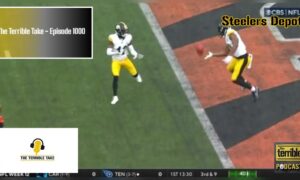Rule 12, Section 2, Article 8 in the 2010 NFL Rule book was talked about in length this morning as NFL V.P. of football operations Ray Anderson joined Mike and Mike this morning on ESPN Radio. Anderson said today, “We\’re not changing any rule.” Instead, Anderson said that the league will be beefing up the enforcement of the existing rules. “If there are flagrant and egregious violations of our current rules, we will be enforcing effective immediately discipline at a higher level,” Anderson said. “We need to get our players firmly in line with the current rules, and that\’s what our intentions are, effective immediately.”
Below is that full section we have copied from the rule book so you can see exactly how it is written in reference to the interview.
Audio can be heard below:
[audio:http://cdn11.castfire.com/audio/303/2117/7825/440909/audiomikeandmike_2010-10-19-103709-3953-0-0-0.32.mp3?cdn_id=15]
Rule 12, Section 2, Article 8
Unnecessary Roughness
Article 8 There shall be no unnecessary roughness. This shall include, but will not be limited to: (a) striking an opponent anywhere with the foot or any part of the leg with a whipping motion; (b) contacting a runner out of bounds; Note: Defensive players must make an effort to avoid contact. Players on defense are responsible for knowing when a runner has crossed the boundary line, except in doubtful cases where he might step on a boundary line and continue parallel with it. (c) a member of the receiving team cannot go out of bounds and contact a kicking team player out of bounds. If this occurs on a kick from scrimmage, post-possession rules would apply if appropriate (9-5-1); (d) running or diving into, or throwing the body against or on a ball carrier who falls or slips to the ground untouched and makes no attempt to advance, before or after the ball is dead; (e) unnecessarily running, diving into, cutting, or throwing the body against or on a player who (i) is out of the play or (ii) should not have reasonably anticipated such contact by an opponent, before or after the ball is dead; or throwing the runner to the ground after the ball is dead;
Impermissible Use of Helmet and Facemask
(f) If a player uses any part of his helmet (including the top/crown and forehead/”hairline” parts) or facemask to butt, spear, or ram an opponent violently or unnecessarily. Although such violent or unnecessary use of the helmet and facemask is impermissible against any opponent, game officials will give special attention in administering this rule to protecting those players who are in virtually defenseless postures, including but not limited to: (1) Forcibly hitting the defenseless player’s head, neck, or face with the helmet or facemask, regardless of whether the defensive player also uses his arms to tackle the defenseless player by encircling or grasping him; or (2) Lowering the head and violently or unnecessarily making forcible contact with the “hairline” or forehead part of the helmet against any part of the defenseless player’s body; or (3) “Launching” (springing forward and upward) into a defenseless player, or otherwise striking him in a way that causes the defensive player’s helmet or facemask to forcibly strike the defenseless player’s head, neck, or face—even if the initial contact of the defender’s helmet or facemask is lower than the defenseless player’s neck. (Examples: a defender buries his facemask into a defenseless player’s high chest area, but the defender’s trajectory as he leaps into the defenseless player causes the defender’s helmet to strike the defenseless player violently in the head or face; or a defender, using a face-on posture or with his head slightly lowered, hits a defenseless player in an area below the defenseless player’s neck, then the defender’s head moves upward, resulting in strong contact by the defender’s mask or helmet with the defenseless player’s head, neck, or face [an example is the so-called “dip and rip” technique]). Note: The provisions of section (f) do not prohibit incidental contact by the mask or noncrown parts of the helmet in the course of a conventional tackle on an opponent. (g) if the initial force of the contact by a defender’s helmet (including facemask), forearm, or shoulder is to the head or neck area of a defenseless player. Note: Defenseless players in (f) and (g) shall include (i) a player in the act of or just after throwing a pass; (ii) a receiver catching or attempting to catch a pass; (iii) a runner already in the grasp of a tackler and whose forward progress has been stopped; (iv) a kickoff or punt returner attempting to field a kick in the air; and (v) a player on the ground at the end of a play.
(h) If a receiver has completed a catch and has not had time to protect himself, a defensive player is prohibited from launching (springing forward and upward) into him in a way that causes the defensive player’s helmet, facemask, shoulder, or forearm to forcibly strike the receiver’s head or neck area—even if the initial contact of the defender’s helmet, facemask, shoulder, or forearm is lower than the receiver’s neck.
Note: Launching is defined as springing forward and upward by a player who leaves his feet to make contact on the receiver. (i) a kicker/punter, who is standing still or fading backwards after the ball has been kicked, is out of the play and must not be unnecessarily contacted by the receiving team through the end of the play or until he assumes a distinctly defensive position. During the kick or during the return, if the initial force of the contact by a defender’s helmet (including facemask), forearm, or shoulder is to the head or neck area of the kicker/punter, it is a foul. (j) any player who grabs a helmet opening of an opponent and forcibly twists, turns, or pulls his head. (k) Illegal contact with the helmet against the knee of the snapper during an attempt for a field goal or kick try. Penalty: For unnecessary roughness: Loss of 15 yards. The player may be disqualified if the action is judged by the official(s) to be flagrant. Note: If in doubt about a roughness call or potentially dangerous tactics, the covering official( s) should always call unnecessary roughness. A.R. 12.17 Third-and-20 on A30. Runner A1 runs to the A33, where he is tackled by B1, who hooks his fingers under the front of the runner’s helmet, but not his facemask, and forcibly twists his head. Ruling: 15 yards for unnecessary roughness. It is an automatic first down. A’s ball first-and-10 on A48.







